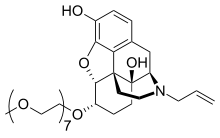Naloxegol
Naloxegol (INN; PEGylated naloxol;[1] trade names Movantik and Moventig) is a peripherally acting μ-opioid receptor antagonist developed by AstraZeneca, licensed from Nektar Therapeutics, for the treatment of opioid-induced constipation.[2] It was approved in 2014 in adult patients with chronic, non-cancer pain.[3] Doses of 25 mg were found safe and well tolerated for 52 weeks.[4] When given concomitantly with opioid analgesics, naloxegol reduced constipation-related side effects, while maintaining comparable levels of analgesia.[5]
 | |
| Clinical data | |
|---|---|
| Trade names | Movantik, Moventig |
| Other names | NKTR-118 |
| AHFS/Drugs.com | movantik |
| License data | |
| Pregnancy category |
|
| Routes of administration | Oral |
| ATC code | |
| Legal status | |
| Legal status |
|
| Pharmacokinetic data | |
| Protein binding | ~4.2% |
| Metabolism | Hepatic (CYP3A) |
| Elimination half-life | 6–11 h |
| Excretion | Feces (68%), urine (16%) |
| Identifiers | |
IUPAC name
| |
| CAS Number | |
| PubChem CID | |
| ChemSpider | |
| UNII | |
| KEGG | |
| ChEBI | |
| CompTox Dashboard (EPA) | |
| Chemical and physical data | |
| Formula | C34H53NO11 |
| Molar mass | 651.785 g/mol g·mol−1 |
| 3D model (JSmol) | |
SMILES
| |
InChI
| |
The most common side effects are abdominal pain, diarrhea, nausea, flatulence, vomiting and headache. As a pure opioid antagonist Naloxegol has no potential for abuse.
Naloxegol was previously a Schedule II drug in the United States because of its chemical similarity to opium alkaloids, but was recently reclassified as a prescription drug after the FDA concluded that the impermeability of the blood-brain barrier to this compound made it non-habit-forming, and so without the potential for abuse—specifically, naloxegol was officially decontrolled on 23 January 2015.[6]
Medical use
Naloxegol is indicated for the treatment of opioid-induced constipation (OIC) in patients with chronic non-cancer pain. It is recommended that any maintenance laxative be discontinued before starting naloxegol or be held for at-least 3 days. Naloxegol should be taken on an empty stomach at least two hours after the last meal.[7]
Pharmacodynamic properties
Naloxegol inhibits opioid binding in μ-opioid receptors in the gastrointestinal tract, thus decreasing the constipating effects (slowing of gastrointestinal motility and transit, hypertonicity, increased fluid reabsorption) associated with opioids.[8]
If naloxegol is coadministered with other opioid antagonists, there is a potential for additive effect and increased risk of opioid withdrawal.[7]
Mechanism of action
Chemically, naloxegol is a pegylated (polyethylene glycol-modified) derivative of α-naloxol. Specifically, the 6-α-hydroxyl group of α-naloxol is connected via an ether linkage to the free hydroxyl group of a monomethoxy-terminated n=7 oligomer of PEG, shown extending at the lower left of the molecule image at right. The "n=7" defines the number of two-carbon ethylenes, and so the chain length, of the attached PEG chain, and the "monomethoxy" indicates that the terminal hydroxyl group of the PEG is "capped" with a methyl group.[9] The pegylation of the 6-α-hydroxyl side chain of naloxol prevents the drug from crossing the blood-brain barrier (BBB).[5] As such, it can be considered the antithesis of the peripherally-acting opiate loperamide which is utilized as an opiate-targeting anti-diarrheal agent that does not cause traditional opiate side-effects due to its inability to accumulate in the central nervous system in normal subjects.
See also
- Alvimopan (trade name Entereg)
- Methylnaltrexone (trade name Relistor)
- Naldemedine (trade name Symproic)
- (+)-Naloxone - a non-opioid drug which also reduces some side effects of opioids without significantly affecting analgesia when used in small oral doses
- 6β-Naltrexol (6α-hydroxynaltrexone) - an investigational medication
References and notes
- Roland Seifert; Thomas Wieland; Raimund Mannhold; Hugo Kubinyi; Gerd Folkers (17 July 2006). G Protein-Coupled Receptors as Drug Targets: Analysis of Activation and Constitutive Activity. John Wiley & Sons. p. 227. ISBN 978-3-527-60695-5. Retrieved 14 May 2012.
- "Nektar | R&D Pipeline | Products in Development | CNS/Pain | Oral Naloxegol (NKTR-118) and Oral NKTR-119". Archived from the original on 2012-02-13. Retrieved 2012-05-14.
- "FDA approves MOVANTIK™ (naloxegol) Tablets C-II for the treatment of opioid-induced constipation in adult patients with chronic non-cancer pain". 16 September 2014. Archived from the original on 2015-05-10.
- Webster, L.; Chey, W. D.; Tack, J.; Lappalainen, J.; Diva, U.; Sostek, M. (Oct 2014). "Randomised clinical trial: the long-term safety and tolerability of naloxegol in patients with pain and opioid-induced constipation" (PDF). Aliment. Pharmacol. Ther. 40 (7): 771–9. doi:10.1111/apt.12899. PMID 25112584.
- Garnock-Jones KP (2015). "Naloxegol: a review of its use in patients with opioid-induced constipation". Drugs. 75 (4): 419–425. doi:10.1007/s40265-015-0357-2. PMID 25666542.
- "Schedules of Controlled Substances: Removal of Naloxegol From Control". www.deadiversion.usdoj.gov. Archived from the original on 2016-03-09. Retrieved 2016-02-27.
- "Movantik prescribing information highlights". AstraZeneca. Retrieved 2019-08-14.
- Garnock-Jones, Karly P. (2015-03-01). "Naloxegol: A Review of Its Use in Patients with Opioid-Induced Constipation". Drugs. 75 (4): 419–425. doi:10.1007/s40265-015-0357-2. ISSN 1179-1950.
- Technically, the molecule that is attached via the ether link is O-methyl-heptaethylene glycol [that is, methoxyheptaethylene glycol, CH3OCH2CH2O(CH2CH2O)5CH2CH2OH], molecular weight 340.4, CAS number 4437-01-8. See Pubchem Staff (2016). "Compound Summary for CID 526555, Pubchem Compound 4437-01". PubChem Compound Database. Bethesda, MD, USA: NCBI, U.S. NLM. Archived from the original on 2016-02-05. Retrieved 28 January 2016.